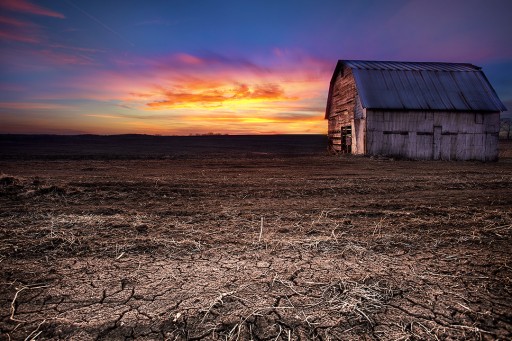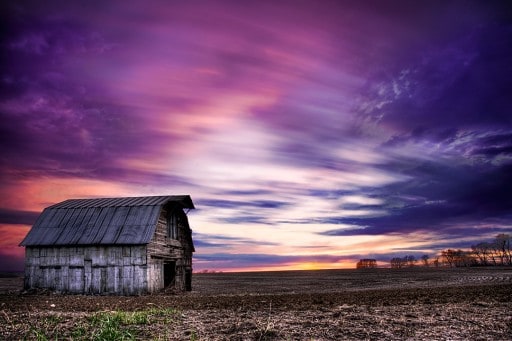I purchased the Canon 17-40 mm lens in October of 2013. If you look in my gallery you will see that I tend to shoot pretty wide open on the focal length. I own a telephoto, but I pride myself in my wide angle lens selection. In October, I wanted more than what my 24-105 mm could offer.
First, I must preface this article with my camera, because this lens will have varying effects based on your camera whether it is a crop sensor or a full frame (Canon 5D Mark II & III and the 6D). All of these images were shot with the Canon 6D.
Camera Sensor |
Focal Length Equivalent |
Full Frame |
17-40 mm |
1.6x Crop |
28-65mm |
Hands down I have to say this lens is incredible! In my line of work (landscape photography) it is a must! I have used many wide angle lenses in my career and find this one to be one of the best. It, of course, has quite a bit of distortion on the 17mm side, but what wide angle lens wouldn’t? I have come up with several ways to overcome the distortion in post processing so I do not lose the magic of a sweeping landscape at a wide open focal length like 17mm. One of those ways can be seen at the end of this review.
Since October of last year I think I may have only done 3 lens swaps! This has become my go-to lens because I know no matter what I am going to get something awesome at the end of the shutter click. Especially at low angles, like the image below.

17-40 with the Lee Big Stopper attached.
The difference between the 17-40 and the 16-35:
It took me quite a bit of time to settle on the 17-40 as I was battling with the idea of the 16-35mm. Anyone who has looked into the Canon Wide Angle line knows that these two lenses are very close in focal length, but the 16-35 is twice as expensive. The major factor in the price difference is the aperture. The 17-40mm has a maximum aperture of f/4.0, while the 16-35mm boasts a beautiful f/2.8! However, the 17-40 comes in at just under $900 on Amazon, while the 16-35mm is around $1700.
I tossed around the idea of the 16-35 for quite some time. When I say quite some time, I mean it took me nearly 3 months to decide. I did a ton of research! I found a lot of helpful advice from Ken Rockwell, if you have never checked out his reviews I highly recommend them. Since I did not have the luxury of shooting with both lenses I was really at the mercy of my research and the knowledge of my camera to determine which one I should purchase.

Same barn, same setup, different sunset.
Why I decided to go with the 17-40mm lens
After reading about both extensively on many forums and Ken Rockwell’s site, I determined 3 things.
The first was that 1 mm may not be that big of a difference on a full frame camera. My initial thought about that one extra millimeter was that I would probably just find more distortion there and would need to do more work in post processing to get it precisely where I wanted it. Wide Angle lenses produce so wicked distortion, especially on straight lines like buildings and interiors. It is easy to fix after the fact if you own Photoshop, it is just one more step you have to take.
The second thought (which was more like a novel in my head) was the maximum aperture difference, precisely, the difference between a whole stop. I battled with the f/2.8 and f/4.0 difference for hours and finally determined that with the ISO technology in the Canon 6D, I could very easily double my ISO to make up for the aperture difference. Sure, I would miss out on any bokeh that the extra f-stop would offer, but you can always fake it till you make it in Photoshop right?
The third thing that was an added bonus, but not a necessity, was that it has the same 77mm threads as my 24-105mm. Any photographer knows that filters and lens accessories can get pretty pricey. However, if the accessory can be used on multiple lenses, then you get the most bang for your buck! I also own the Lee Big Stopper with the setup for a 77mm lens and it is nice that both lens can share the pleasure of the Big Stopper!

Vertorama with the 17-40 mm lens. This was 5 HDR images shot horizontally to create a vertical panorama.
In Closing
If you are anything like me, you are probably seeing this review because you are trying to determine which lens to sell your soul to. I have had nothing but success with this lens and would buy it again in a heartbeat. This is a great lens and well worth the money for any landscape or interior architecture photographer.
Although, if I had the $1700 to drop without any buyers remorse, I would probably have gone with the 16-35mm. However, the price difference is about 31 large boxes of diapers, you can see where my priorities lie. I can only imagine how much of a beast it is if the 17-40 is such a miracle worker.
Like this tutorial? Want Full Workflow tutorials? Try HDRInsider










Hi Blake,
I´m using this amazing lens since 4 years. First on my 450D and since 2011 on my EOS 60D.
All I could say: I´m loving it!
Also on a crop-cam like my 60D it takes amzing quality on my images.
I´m also using a sigma 10 – 20mm for my images, but only then, if I couldn´t stay far enough from the subject from which I will take a shot.
The canon 17 – 40mm l usm is my most used lens. Like I told before, the quality is amazing.
Kind regards
Harry
It is a great lens. It rarely leaves my camera. I usually take it off to shoot close-ups of the family, but other than that, I want all my photos as wide open as possible, the look from a low angle shot with a wide lens like this is just phenomenal!
Thanks for your insight!
I, also, agonized over these two lenses for some time. The 16-35mm has such a strong reputation, it was very tempting to spend the extra money. There were some harsh reviews of the 17-40mm, adding to the motivation to get the 16-35mm. Oh, the lure of f/2.8! After much consideration, I chose the 17-40mm also. The biggest reason was cost. Saving the money by not purchasing the 16-35mm allowed me to buy a speed light. I have been very pleased with this lens. Despite some complaints about softness, I have not found this to be the case. My copy is tack sharp and on my 5D MK II, it is very wide. It also helps that I have the 35mm f/1.4, giving me excellent shallow depth of field when that is my desire.
We went through the same thing! I took a chance on it and would do it all over again! Beautiful lens and tack sharp as you mentioned. However, the thought of the 2.8 and that one extra millimeter really drives the lens envy home!
I struggled with the same thig you struggled with. Choosing a good and fast wide angle lens for a good price. The solution I came up with was to purchase a 17-35 f/2.8 L. Yeah it’s an older lens, but it works amazingly well.
Hmm, 17-35. Just looked it up. I couldn’t find that option during my research. When it comes to lenses the technology never really gets old, that is the prime advantage of buying good glass over a newer camera body!
I’ve been adding to my lens collection slowly, but like you, I have to look at a variety of things. Utility and price are major factors when selecting equipment. My camera is a Canon, but not high end at this time. I wish that I could get a list of the different lens designations so that I can really compare apples to apples.
Yes! It is a slow process! It is difficult to come up with a good comparison list, they have so many options! Typically anything L means expensive, but expensive because the quality is phenomenal and the build is durable! The L series glass 95% of the time will outperform any lesser lens.
The one lens I do own that is not L because of the rave reviews it received was the 85mm 1,8. Great lens, but HORRIBLE macro capabilities. The L glass I own is much better for that (24-105 and 17-40).
Hello Blake.
Have been a follower of your site for some time now. Excellent tutorials…keep it up.
Not to brag or dispell what the others have said, but I own both the 17-40 and the 16-35 Canon lenses. When my wife recently became interested in photography, I gave her the 17-40 and I bought the 16-35. On every level, the 16-35 exceeds the capabilities of the 17-40. I understand the cost factor and it cannot be ignored. But the 16-35 is an amazing lens on my 5D Mark II.
Best wishes.
Hi Blake,
Help me understand why you value the extra width of the 17mm over the 24 mm in your shooting experience.I am a Nikon shooter and have the 24 to 120 f4 lens and the 14 to 24 F2.8 lens. First of all, I agree that with the modern cameras, f2.8 versus f4 is not as big a deal as it once was. But my problem is in understanding why the extra width is so valued. I know most PROs prefer the wider lens. Can you explain what you feel it adds to your shooting?
Thanks,
Gordon
Hello Gordon! The 24-105 is a great lens, but the wider focal length of the 17mm allows me to get more of the scene into one frame. It really expands the scene quite a bit. I did a blog post on this a while back with my old Olympus E-30 comparing the 14mm (28mm equivalent) to the 11mm (22mm equivalent). You can see a drastic difference even in 3 mm (or 6 mm because of the crop factor of the sensor). Here is the post on it.
The extra wide focal length allows for more creativity on top of the addition of getting more in one frame. Due to the distortion that happens there is a sense of mystery to the shot, especially at lower angles, the landscape appears to ‘sweep’ a bit more. However, with that distortion comes some negative things that I discuss and fix in the video tutorial.
Hi Blake,
I am a Nikon user and have a d300 and d700 bodies. When I bought my d700 it was to take underwater with a housing and two underwater strobes. I bought all necessary gear to shoot macro and wanted to be able to shoot wide angle as well. I ended up the 14-24mm f2.8 lens and used a huge 70mm extension on the front of my housing and a 81/2 inch dome port. After some time in the water with this lens it was quite obvious that it was not going to be the best lens for wide angle. Had terrible distortion half way across the image right through to the corners, so I did some more home work and found that between the 16-35mm f2.8 and the 17-35mm f4 that one was better for underwater and one was better for topside. As I as primarily only doing underwater I sold the 14-24mm lens and went on and purchased the 16-35mm. I have not mastered what I consider good wide angle
underwater photography yet and haven’t done much diving in the last 12 months. I do need to use at +2 diopter for this lens underwater and have still to practice more. Because I have done hardly any diving I have spent more time learning about HDR photography and have joined you HDRInsider group and love it. I use this lens now more for my landscapes and seascapes and do love it. My two other lens I use most for topside are the 24-70mm f2.8 and the 70-200mm f2.8 and I love them all. I have a few other speciality lens I used under water like 60mm macro, 105mm macro and the Tokina 10-17 fisheye lens which is actually easier to use than the 16-35mm lens. I have mostly top prices lens as my husband buys them for me as gifts which I love. I would love something longer than the 200mm but will probably settle to buy a 2.0 teleconverter as the cheapest option to get my 400mm option on this lens. I love lenses and filters and just add bit by bit to my kit.
My wife and I are both avid photographers and we have both the 17-40 and 16-35. For most images I would have a hard time discerning which lens was used after the fact. However, there is one specific scenario where the 16-35 is a better investment. If you are doing night photography, especially shooting the Milky Way, that extra f-stop makes a huge difference. If you are only doing star trail images than the 17-40 is fine. But for still images at night you really notice a difference with the faster lens.
Sweet thanks for the heads up. I was looking at upgrading this week. Maybe I’ll just get a Macro lens 🙂
The are both constant aperture, the 17-35 is f4 and the 16-35 id f2.8. Constant aperture will always cost more than variable and the 2.8 will always cost more than the 4.0. It depends on what you want to us it for. I have Canon 35, 50, 85 and 100 mm primes all f2.0 or less as I shoot theater and musicians in very low light without a flash. I also have the Canon 70-200 f2.8. I went from a Canon 350D to a 40D and now have a 7D. I learned the hard way….Find your niche and buy glass to suit your needs. I bought 3 lenses and wound up selling them as they did not suit what I like to shoot.
Hi, thank you for this useful article. I really appreciate it. I own a Canon 6D with 24-105mm and can’t decide between 16-35 and 17-40 (as many others!) for indoor and landscape photography. As per today (26/03/15) prices have changed and I can get the 16-35 f/4L IS USM for 960 USD while the 17-40 f4L USM is 705 USD (255 USD less). Since I always try to save money for traveling, I have a question for you guys: If you had to buy either one of those 2 lens today, which one would you chose?
Thanks again for your priceless opinion!
Andrea
I would spend the extra money on the 16-35 f/4. That lens was not an option when I bought the 17-40.